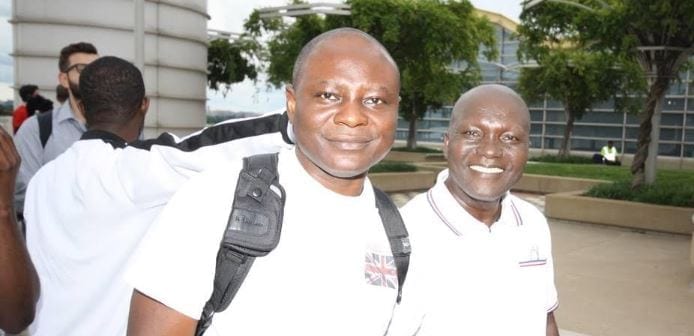
Jul 31, 2019
After more than 10 years of partnership with agricultural workers on the Firestone Liberia rubber plantation in Harbel, the company is increasingly backtracking, including the unilateral firing of 13 percent of its workforce, says the Agriculture Agro-Processing and Industrial Workers Union of Liberia (AAIWUL). As the country’s largest employer—and therefore its employment-standards trendsetter—the union says the company’s reversal is having devastating consequences on the livelihood, rights and dignity of Liberia’s workers.
“Although we want jobs, we want good jobs,” said AAIWUL General Secretary Edwin Cisco. “Firestone Liberia is key.”
Workers’ gains on the Firestone Liberia plantation have increased in successive negotiated agreements with the company since 2008, including an end to child labor, improved pay, lower daily production quotas for rubber tappers, mechanized transportation of latex, improved housing, free education for workers’ children and access to medical clinics for workers and their families. The company’s partnership with its workers and subsequent improvements in conditions and pay have set country-wide standards for acceptable conditions of work.
“Generation after generation of workers suffered. We cannot go back,” said Cisco.
Unfortunately, since former president Ellen Johnson Sirleaf’s leadership ended in 2018, Firestone Liberia is increasingly reversing direction. The company, AAIWUL says, is reneging on its promises and undermining the union with unlawful dismissals of its leaders and large-scale layoffs of full-time union members, who are being hired back as contract workers.
“They are paid off with pain in their hearts,” said AAIWUL President Abraham Nimene.
Firestone Liberia is setting a bad example for other employers investing in the country, including multinational palm oil companies such as Golden Veroleum, which AAIWUL is organizing. Workers harvesting palm oil sought the union’s help to remedy appalling conditions—including workers’ use of dangerous chemicals without personal protection or other safety measures.
In the union’s most serious challenge, Firestone Liberia is increasingly funneling full-time union members into informal contract positions. 320 workers laid off earlier this year were rehired as contractors, joining 2,505 other contractors already working without the benefits accruing to full-time workers. Contract employees are doing the same work as full-time workers, says AAIWUL, for less pay, under worse conditions and without the wages, benefits and social protections enjoyed by full-time workers who are represented by the union. The company says that more layoffs are coming next month.
“They are going to turn the entire workforce into precarious work, and we can’t allow this to happen,” said Nimene.
By AAIWUL’s calculations, 830 jobs have been lost so far this year, after Firestone imposed transfers to contract positions, lay-offs and forced retirements. Although the company says job losses are caused by concessions it made to the country under the Sirleaf government as well as low natural rubber production and decreasing global natural rubber prices, AAIWUL criticizes the company’s lack of transparency in its financial hardship claim. Wages remain low, says AAIWUL. Although president and managing director of Firestone-Liberia, Edmundo Garcia, told the Liberia House of Representatives in 2018 that the lowest wage paid to locally hired workers is $8.36 per day, AAIWUL says that the company’s minimum daily wage for local hires is only $5.60 per day. Production on the plantation continues, said Cisco, but with increasingly exploited, precarious workers.
“We want … the basic labor rights of workers maintained,” he said.
Firestone Liberia, an indirect subsidiary of Bridgestone Americas Inc., is the largest contiguous natural-rubber producing operation in the world. The company supplies Bridgestone with raw and block latex with which to manufacture tires in the United States.
A series of agreements between workers and Firestone Liberia between 2008 through 2019 addressed conditions described in a 2006 human rights lawsuit against the company as “the modern equivalent of slavery.” After a more than one-year struggle, Firestone Liberia plantation workers signed their first agreement with the company in 2008, marking the first time the company’s workers were represented by an independent union in Firestone Liberia’s 82-year history.
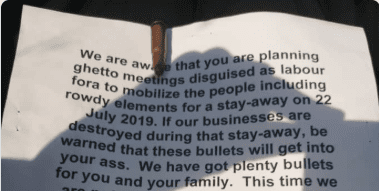
Jul 18, 2019
Bullets and an anonymous death threat were delivered to Zimbabwe Congress of Trade Unions (ZCTU) President Peter Mutasa and Secretary General Japhet Moyo yesterday in an apparent attempt to discourage a planned labor action later this month.
“This is the first time, for all we know in our history, that bullets are delivered at the homes of trade union leaders, said ZCTU in response.
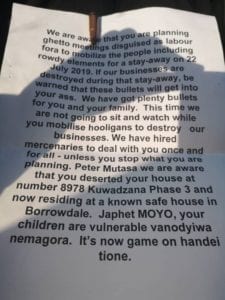
Union leaders in Zimbabwe say this is the first time leaders have been threatened with death for seeking to exercise freedom of association. Credit: ZCTU
The identical threatening letters warn Mutasa and Moyo not to participate in an upcoming July 22 work stoppage by ZCTU members who, with other civil society groups, have been protesting rising prices in the country—including a 150 percent fuel price hike.
If Mutasa and Moyo “mobilize the people” the letter warns, the letter’s authors have hired mercenaries “to take care of you once and for all,” “have got plenty of bullets for you and your families” and know where Mutasa–currently in hiding for his own safety—is living.
“It’s now game on,” the letter ends.
ZCTU has faced numerous threats from authorities while Zimbabwe’s economy continues to flounder and inflation and price hikes further complicate Zimbabwean workers’ lives.
Mutasa has been forced into hiding by ongoing violence and intimidation by authorities. After ZCTU helped organize a national strike in January this year to protest price hikes, police seeking Mutasa allegedly assaulted his brother at his home. ZCTU staff also reported intimidation by police. Arrested and charged with subversion, Mutasa and Moyo have since remained in legal limbo as the Zimbabwe government repeatedly postpones their trials.
January’s violent clashes resulted in 12 deaths and 320 injuries, blamed by human rights organizations on the army and police.
In the aftermath of a similar protest in October last year, some trade unionists were beaten, Mutasa, Moyo and 33 other trade unionists were arrested, senior ZCTU leadership was forced into hiding and ZCTU Harare offices were cordoned off by some 150 policemen. The Zimbabwe Human Rights Commission found that torture of protesters by government forces before and immediately after the October national protest—consisting mostly of “indiscriminate and severe beatings”—was widespread.
An attempted fact-finding visit by a delegation of the International Trade Union Confederation (ITUC) in February this year resulted in denial of visas for most of the delegation and the arrest of ITUC-Africa Secretary General Kwasi Adu Amankwah by state security.
The majority of Zimbabwean workers eke out a living in the informal economy, struggling to survive on less than $1 a day. Those with formal jobs often do not fare well either. A 2016 study by the Solidarity Center found that 80,000 workers in formal jobs did not receive wages or benefits on time, if at all. In many cases, they made only enough to get to work.

Jul 8, 2019
Some 650 million workers around the world earn less than 1 percent of global income—a figure that has barely changed in 13 years, according to a new International Labor Organization (ILO) report. At the national level, the share of income going to workers is actually falling, decreasing from 53.7 percent in 2004 to 51.4 percent in 2017.
“The average pay of the bottom half of the world’s workers is just $198 per month and the poorest 10 percent would need to work more than three centuries to earn the same as the richest 10 percent do in one year,” says Roger Gomis, an economist in the ILO Department of Statistics.
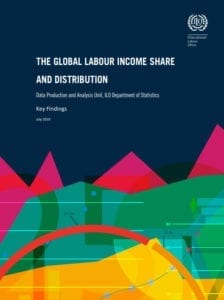 The report pushes back on the widely held view that overall income inequality is declining in the global south. Rather, increasing prosperity in China and India is skewing the data, which indicate pervasive income inequality in jobs around the world.
The report pushes back on the widely held view that overall income inequality is declining in the global south. Rather, increasing prosperity in China and India is skewing the data, which indicate pervasive income inequality in jobs around the world.
Overall, 10 percent of workers receive 48.9 percent of total global pay, while the lowest-paid 50 percent of workers receive just 6.4 percent, a new ILO dataset reveals, the ILO Labor Income Share and Distribution finds.
And the more top earners make, the less everyone else is paid, according to the report. But when income of middle- and lower-paid workers rises, everyone but the top earners gain.
The pay gap is especially large in struggling economies. In sub-Saharan Africa, the bottom 50 percent of workers earn only 3.3 percent of labor income, compared with the European Union, where the same group receives 22.9 percent of the total income.
“The majority of the global workforce endures strikingly low pay and for many having a job does not mean having enough to live on,” Gomis says.
Get Involved with Sustainable Development Campaign
The ILO data, requested by the ILO Global Commission on the Future of Work, will be used to monitor progress toward the United National Sustainable Development Goals (SDGs.) Representatives from around the world are set to meet this month for the High-Level Political Forum on some of the sustainable development goals, including SDG 8, which focuses on promoting sustained, inclusive and sustainable economic growth, full employment and decent work for all.
(The International Trade Union Confederation has launched a #Timefor8 campaign. Find out how you can take part.)
The ILO Labor Income Share and Distribution dataset includes 189 countries and provides the first internationally comparable figures of the share of GDP that goes to workers—rather than capital—through wages and earnings. It also looks at how labor income is distributed.
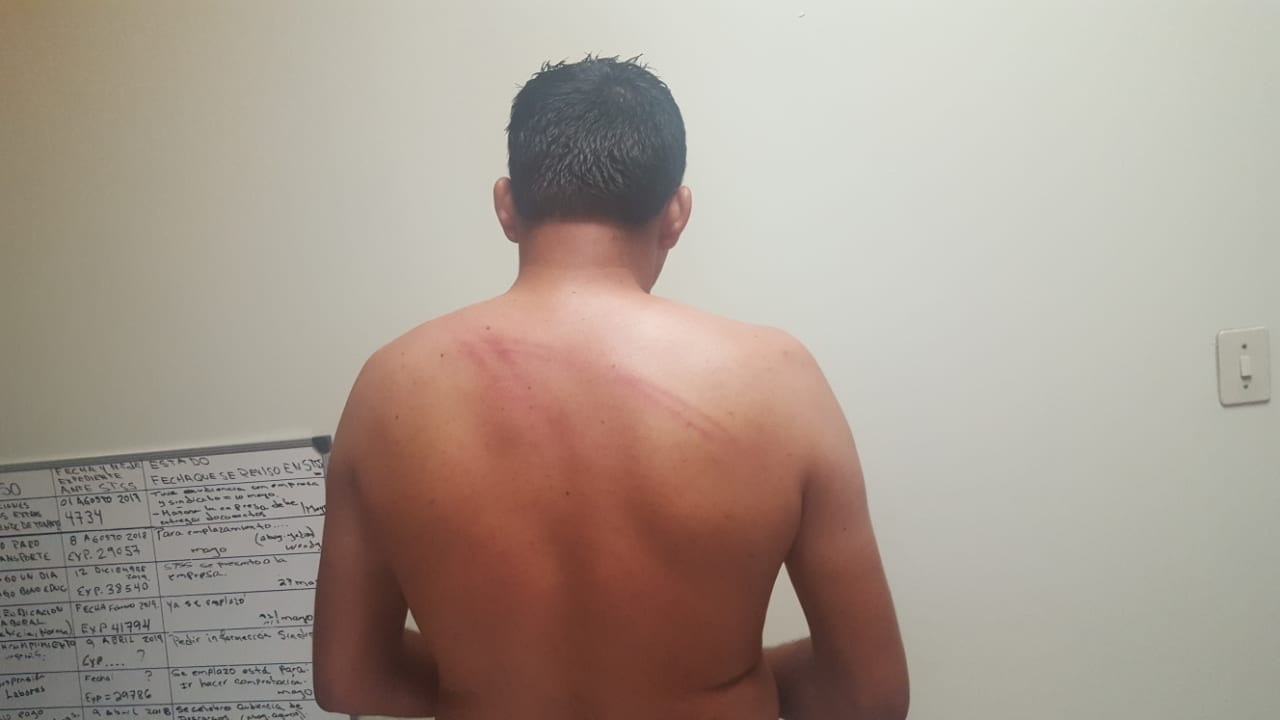
Jul 1, 2019
One union activist from the Workers’ Union of the Gildan Villanueva S.A. (SITRAGAVSA) was murdered and at least three others attacked during recent protests against the Honduran government’s efforts to privatize the country’s education and health systems, according to an independent human rights monitor, who will not be identified out of safety concerns.
The Platform for the Defense of Health and Public Education, a coalition of union and community organizations, led protests across the country in May and June. Security forces repeatedly responded by firing at protesters with live ammunition and tear gas.
Joshua Sánchez, 22, a union member, was shot in the head by police during protests in Villanueva after he sought refuge in a shop (see video), according to witnesses interviewed by the human rights monitor. Sanchez leaves behind a 4-year-old son.

Abel Martel received head wounds from assault by Honduran national police.
Among union leaders wounded, Nahún Rodríguez, president of SITRAGAVSA, was assaulted and threatened by a military policeman during protests in Villanueva, according to the human rights monitor. Abel Martel, SITRAGAVSA secretary general, was assaulted by national police and union delegate Skeyla Suyapa Gomez received a face wound from a tear gas bomb dropped by the national police. The union leaders, workers at apparel factories, joined thousands of teachers and health care workers in solidarity with their struggle and to demonstrate the importance of maintaining quality public services for all Hondurans.
Spending on education and culture has dropped from 33 percent of the national budget to 20 percent over the past decade, with wages and infrastructure spending frozen. Some 40 percent of emergency rooms have inadequate medical coverage, according to the Honduras National Commission for Human Rights. Educators and health care workers say privatizing health and education systems will further decrease services and lead to layoffs.
Few Perpetrators Brought to Justice Despite Global Condemnation
The Network Against Anti-Union Violence in Honduras, which each year issues a report documenting violence against and murders of Honduran union leaders and members, is among local and international organizations denouncing the deadly crackdown. Yet despite widespread global condemnation, union leaders and members continue to be targeted, and few, if any, perpetrators are brought to justice.
The International Labor Organization this month issued its second complaint against the Honduran government in as many years over the continuing attacks on union activists, indicating its serious concern regarding “the allegations of acts of anti-union violence, including the allegations of physical aggression and murders, and the prevalent climate of impunity.”
In 2012, the AFL-CIO and 26 Honduran unions and civil society organizations filed a complaint under the labor chapter of Central American Free Trade Agreement (CAFTA). The complaint, filed with the U.S. Department of Labor’s Office of Trade and Labor Affairs, alleges the Honduran government failed to enforce worker rights under its labor laws. In a February 2015 report, the U.S. Trade and Labor Affairs office said Honduras had made virtually no progress since 2012.
Jun 26, 2019
“Defunding the programs that protect vulnerable people’s human rights and meet their basic needs is a nonsensical approach to combating trafficking,” said Shawna Bader-Blau, the executive director of the Solidarity Center, a global workers rights organization that operates in 60 countries and has been affected by the Trump administration’s decisions.







